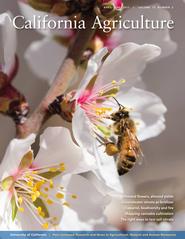All Issues

A honeybee, Apis mellifera, collects pollen from an almond flower at Sloughside Farms in Yolo County. The golden bulb on the bee’s hind leg is pollen packed into a specialized structure called a pollen basket, or corbicula. Photo by Will Suckow.
Editor Jim Downing talks about what's in the current issue of California Agriculture journal — mapping soil salinity by satellite; evaluating crop ownership patterns in California; growing oilseeds in winter without irrigation; seeding rangelands; keeping dairy cows cool; and pedagogical lessons for volunteer educators.
Volume 71, Number 2
News and opinion
Building sustainable livelihoods around our farms, ranches, forests and rivers.
Van Butsic is pioneering the study of how California's richest crop affects rural landscapes.
Long-term studies at Hopland Research and Extension Center find no simple answers for reducing fire risk while conserving biodiversity.
The dark ash left by a chaparral fire is rich in ammonium nitrogen; can the ecosystem absorb it before winter rains wash it away?
GivingGarden will connect neighbors through a produce-sharing service. It's superlocal, like NextDoor, but devoted solely to food and gardening.
Recent scientific articles from the Agricultural Experiment Station campuses.





